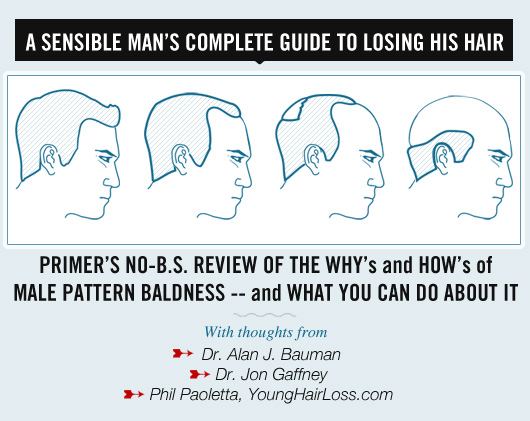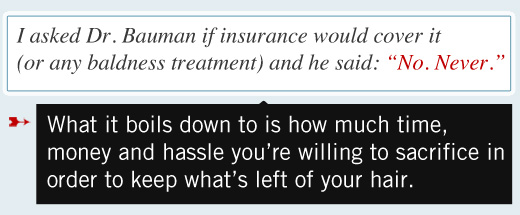It’s happening. Maybe it was a picture from your high school graduation that made you realize how much your appearance has changed. Maybe it was something your dad said in passing or in jest while gesturing at his own head: “A glimpse into the future, son.” Either way, you’re starting to notice it. In the mirror—your hairline receding, your hair beginning to grow finer and shorter.
Could I really be going bald?
You could. No matter how young you may feel, you are never too young to begin losing your hair. To a certain percentage of men, baldness happens.
So, what are you going to do about it?
This article will help you figure that out. We’ll be discussing the causes of male pattern baldness, the hair loss treatments available, their effectiveness, their risks and other things you should know about managing baldness. The goal here will be to present a balanced overview of all your options so you can make an informed decision.
Let’s get started.
Why Am I Going Bald?
Before we talk about why you’re losing your hair, let’s back it up a bit and talk about why you have hair in the first place. You are born with about five million hair follicles on your body. These are the same five million hair follicles you’ll have for the rest of your life. You don’t generate new hair follicles at any point in your life. Rather, each hair follicle goes through a hair growth cycle that consists of three stages: anagen (growth), catagen (rooting) and telogen (rest). Each hair follicle loops through these phases asynchronously, which is why you don’t lose all of your hair at once before the new stuff comes in. Normally, the number of hair follicles in the growth phase will make up for the 25 to 100 hairs you shed each day.
So, basically, each hair follicle is like a little hair factory that outputs according to schedule. Your body chemistry and hormones place the work orders for new hairs, and the follicles produce. But sometimes, your body will send a message that downsizes or shuts these factories down. And once the lights go out, they never come back on again.
DHT and Male Pattern Baldness
There are many causes of hair loss in men. But the most common is called male pattern baldness, or male pattern hair loss. The scientific term is androgenic alopecia. The most prevailing theory of why men go bald has to do with dihydrotestosterone (DHT). DHT is a naturally occurring hormone in the body that is kind of like a souped up form of testosterone. As such, DHT plays an important role in your manly sex drive, aggressiveness and hairiness. Keep that in mind—we’ll come back to DHT’s role later.
Some men’s hair follicles become sensitive to DHT in a bad way. For these guys, DHT will cause the hair follicles to become smaller. As such, the hair it produces becomes thinner and shorter as well. This progresses until the follicle completely shuts down.
Are You Destined for Baldness?
Your hair follicles become sensitive to DHT as you age based on your genes. Male pattern baldness can come from your mom’s side or your dad’s side. That whole thing about skipping a generation is fairly groundless. Your dad or grandpa being bald or having a full head of hair isn’t a definitive way to predict whether or not you’ll go bald, since you may or may not have inherited the DHT sensitivity gene.
However, you can find out if you have the gene by taking the HairDX Genetic Test. Primer consulted with Dr. Alan J. Bauman, a certified member of the American Board of Hair Restoration Surgery and a pioneering hair loss researcher, who explained to us how the test works. In a nutshell, the HairDX test looks for a specific genetic variant of the Androgen Receptor (AR) gene. If it’s there, you have about an 80 percent chance of going bald. If it’s not, you have about a 10 percent chance of going bald. The test costs roughly $175, and it consists of a simple swab from the inside of your cheek.
The nice thing about genetic testing for male pattern hair loss is that it can predict baldness early. That is, before you start noticing the receding hairline and the clumps of hair on your pillow in the morning. Like with cancer, the best medicine for baldness is early detection and prevention. And on that note, let’s talk about what you can do to stave off the insidious effects of DHT on your precious hair.
Fighting Baldness: Your Arsenal
There are no non-surgical ways to regenerate hair follicles or to regrow brand new hair once you go bald. That’s why, as I mentioned before, it’s so important to nip baldness in the bud. Dr. Bauman pointed out that you can lose up to 50 percent of your hair without even knowing it.
Paranoid yet?
Don’t worry. There are a number of weapons at your disposal for the war on DHT, and a handful of plans of attack worth reconnoitering. Each one has some major strengths and weaknesses, which we’ll brief you on before launching your mission.
Rogaine (Minoxidil Topical)
You’ve seen the commercials for Rogaine by now. The active ingredient in this topical treatment is minoxidil. Of all the medicinal treatments we’ll discuss, this one probably gives you the best effectiveness-to-adverse side effects ratio. Rogaine doesn’t directly address the DHT issue. In fact, no one is entirely sure how it works. But over two decades of use have shown that it does appear to stop hair loss and promote thicker hair growth. Minoxidil can also be combined with other treatments, such as Propecia.
But here’s the thing…
When you first start using Rogaine, you’ll actually have an increase in hair shedding before you see any benefit from the treatment. First of all, this is fairly alarming, especially for someone who is anxious about losing his hair. But it gives us some major clues as to how minoxidil works and why it may only be a temporary fix.
Remember when we said that your hair follicle goes through a cycle of growth and rest? Well, when your hair is done growing in length, it just sits there doing basically nothing for a couple of months while waiting for the next growth phase to begin. Telogen, that last phase that we talked about, can last up to 100 days. When anagen begins again, that old hair falls out to make way for the new hair.
Think about that for a moment.
What minoxidil likely does is prematurely reboot that cycle for your healthy hair follicles. That’s why you lose a bunch of hair right away—the new anagen phase is evicting all the telogen hair early. The net effect is that your hair follicles become more in sync, rather than being staggered, as nature intended. So, it appears that you have thicker and fuller hair—which you do. But you don’t have more hair follicles. You just have more hair at once.
All that is conjecture from a non-doctor (i.e. me), but many of those who have tried Rogaine do report that the improvement seems to be temporary. As with all the treatments we’ll discuss (except for surgery), you lose all the benefits of the drug once you stop using it. It doesn’t address the underlying issue—the DHT sensitivity that’s slowly withering your hair follicles away.
Minoxidil advantages: Available without a prescription, hardly any side effects worth mentioning and it does visibly improve the thickness of your hair.
Minoxidil disadvantages: Temporary fix. May not stop the inevitable.
Minoxidil cost: ~$20 to $60 a month; prescription version usually more expensive.
Propecia (Finasteride)
Propecia (finasteride) is the other baldness drug that you’ve already heard of. Like Rogaine, Propecia has been around for a long time—it’s been FDA-approved for treating male pattern baldness since 1997. But unlike Rogaine, Propecia does address the DHT-related cause of baldness. Finasteride is a pill that inhibits 5-alpha reductase, the enzyme that turns testosterone into DHT. Finasteride and other 5-ARI medicines (such as dutasteride, marketed as Avodart) are very effective at stopping hair loss. According to figures cited by Dr. Bauman, Propecia is effective for about 90 percent of men who take it.
So, what’s the catch?
For the majority of men, there isn’t a catch. But there’s a raging controversy about the possible adverse side effects of Propecia that you should definitely read up on before going on the pill. Just Google it and you’ll get more information from more sources than you’ve ever wanted. But I’ll summarize both sides of the debate for you here.
Here’s the thing:
The active ingredient in Propecia, finasteride, is the same drug that’s used in Proscar, a treatment for benign prostatic hypertrophy (BPH, or an enlarged prostate gland). That is, it messes with your junk. More specifically, it alters the natural balance of hormones in your body. It’s significantly changing you—all of you—on a chemical level in order to address an issue that is localized to your head. It’s kind of a blunt instrument. And the hallmark of a blunt instrument is its potential for collateral damage.
Men who experience intolerable side effects from Propecia are a minority. But they are very vocal, and my guess is, that if it happened to you, you would be too. I spoke with Phil Paoletta, who writes the blog YoungHairLoss.com, who completely lost his sex drive while on Propecia. He goes into more detail on his blog:
After avoiding sexual activity for a few days, my girlfriend was also freaked out. I thought maybe it was all in my head so I forced myself to have sex with her (something is seriously wrong with this picture). Here’s where things got scary.
I couldn’t have an orgasm. All the sensation and pleasure of sex was completely absent. Now I was legitimately terrified. I called my doctor. He told me that this occurs in some cases and that it may just be my body adjusting to the medication. Hmm. Ok.
After doing some research, he found other reports of sexual side effects, including loss of libido and erectile dysfunction, as well as depression and other symptoms. But most troubling was that some of the men reported that these adverse side effects remained even after stopping the pill. There are also concerns that 5ARIs increase the probability of certain cancers in men. You can read more stories of horror at propeciahelp.com.
What do the experts have to say about all that? In addition to Dr. Bauman, I also got in touch with Dr. Jon Gaffney, medical director for Hair Club, formerly known as the Hair Club for Men. Hair Club has been around for 35 years, and Dr. Gaffney himself has performed over 14,000 hair transplant procedures. He’s read websites like propeciahelp.com, and here’s what he says:
I personally have literally hundreds of patients on finasteride 1mg (Propecia) and have had no complaints of permanent erectile dysfunction, loss of libido, depression or decreased sperm counts. Occasional patients have shared that they might have had one or more of these symptoms but that everything reverted to normal when they quit taking the 5ARI.
Dr. Bauman, who has been prescribing finasteride for 15 years, agrees with Dr. Gaffney. He says that of the 7,000 patients he’s treated with Propecia/finasteride, not a single one of them has reported persistent side effects after stopping the pill. He also makes a very compelling point about the perceived cause and effect of Propecia and sexual dysfunction or depression.
“Sexual dysfunction in men is unfortunately very common in modern society, so I do believe that there are many men out there who absolutely, 100% have these symptoms,” he says.
But…
“Hair loss is known to be related to depression, anxiety and low self-esteem—all of which can lead to decreased libido and decreased sexual performance,” Dr. Bauman says.
In other words, going bald can be depressing. And the kind of guy who gets depressed by the notion of going bald is usually the same kind of guy who actively seeks out medical help to treat it.
Do your own research, ask your own questions and make your own mind up. That applies to everything in this article.
Propecia advantages: Effective in stopping hair loss in 90 percent of men who take it for male pattern hair loss, according to the experts. Less than 2 percent of patients experience intolerable side effects, which almost always dissipate after stopping the medication.
Propecia disadvantages: Requires prescription. Some men report persistent sexual side effects as well as depression, anxiety and “watery sperm.” If you stop taking the pill, natural continuation of hair loss occurs 100 percent of the time.
Propecia costs: About $80 a month.
Surgical Options
I’m not going to talk too much about surgical options, for two main reasons: (1) it’s too expensive for many men to consider (2) it’s a major and personal decision that should be made only after consulting several good doctors.
Hair restoration surgery is like plastic surgery. There’s an art and a science to it, and the science of surgical hair restoration has come a long ways in the past decades. That being said, responsibly managing your expectations is the key to being happy with the results.
Both Drs. Bauman and Gaffney are hair restoration surgeons by trade, so they obviously recommend the procedure to good candidates. A hair transplant consists of harvesting healthy follicles from other parts of your body and “planting” them in your head. Using the Follicular Unit Extraction (FUE) procedure, hair transplants today are much less invasive and don’t have that “pluggy” look.
The procedure is effective, but it’s not magic. Dr. Gaffney explains it this way:
In spite of advertisements you may have seen, anyone who states that you will get a full head of hair is, sadly, not being honest. Even with the state of the art procedures of today, a full head of hair is not possible. What can be done is likened to rearranging furniture to give a look of fullness. That said, a cosmetic level of density can be attained in the majority of cases to the patients satisfaction.
No matter what, choosing the right surgeon is extremely important. Hair transplant surgery is meant to be life changing—and you want to do everything in your power to ensure that the change is good. Dr. Bauman gave me some excellent pointers on choosing a doctor for your hair restoration surgery which I’ll include as “further reading” because it’s too long to work into this article but too good not to pass it along unabridged.
Other Options
Hair loss is an issue as old and perplexing as humanity itself. In the quest for finding a cure for baldness, man has tried many, many things. Some of them have worked, some of them have been pure snake oil, and some of them have been unmitigated disasters. As science and industry continue to seek answers, more unproven, yet hopeful remedies are beginning to appear on the horizon. Here are a few that you might want to be aware of:
- Low level laser therapy – Welcome to the future, where we cure everything with laser beams, including baldness. There are laser combs that you can use at home as well as in-office laser treatments that cost about $400 a month. The FDA approved low level laser therapy (LLLT) as safe, but no clinical studies have emerged regarding its effectiveness. The good news? No side effects. The bad news? There’s no hard evidence that it’s doing anything at all.
- Saw palmetto extract – An herbal remedy that allegedly does the same thing that Propecia does (i.e. inhibits DHT production). There’s no hard evidence of effectiveness, though. And if it does work as a 5ARI, then it’s reasonable to assume that it would have similar negative side effects.
- Ketoconazole shampoo – An alternative to Rogaine, a small study back in the 90s found that this antifungal drug increases hair density in a similar way as minoxodil. It’s FDA-approved to treat dandruff, but there’s still no credible evidence that this works for baldness. And if it did, you could expect the same drawbacks as Rogaine.
- Latisse (Bimatoprost) – FDA-approved for increasing the lushness of eyelashes, Latisse, hair loss specialists are testing its use for the treatment of baldness. This “off label” use of the product is completely legal, and Dr. Bauman has been prescribing a generic version of Bimatoprost to his patients since 2007. It works for about 70 percent of them, including one man who was featured in the New York Times. Drawbacks? It’s expensive at about $200 to $300 a month. I asked Dr. Bauman if insurance would cover it (or any baldness treatment) and he said: “No. Never.”
- Hair cloning/culturing – The Holy Grail of hair treatments is the ability to grow hair in a lab, either by cloning it or by a cell culture. The good news about hair cloning? We have the technology, and it’s just a matter of time before we perfect it for the market. In fact, some say that it’ll be available within the next five to ten years. The bad news? They’ve been saying that for the last twenty years.
The Ultimate Head Game: Going Bald Like a Boss
When it comes to managing baldness, the theme is pretty consistent no matter where you go: There is hope for balding men young and old, but there are pitfalls as well. What it boils down to is how much time, money and hassle you’re willing to sacrifice in order to keep what’s left of your hair.
If this is the first or fortieth article you’ve read online about going bald, then chances are that you’re approaching the problem or anxiety in search of medical or scientific solutions. But I might challenge you for a moment to look at it differently. Instead of seeing your impending baldness as a battle against nature, try embracing it as an emotional transition in your life.
Hear me out.
Baldness is not a disease. You don’t have too much of one thing in your body or not enough of some other thing. You are turning out exactly as your genes say it should. Baldness is in your DNA. It’s who you are.
Here’s a story about a man who went bald at a very young age. He was 19 years old when he started losing his hair, and he spent years trying to cover it up with hats, toupees and worst of all, a simply god awful comb over. His anxiety over his hair (or lack thereof) consumed an immense amount of his attention and emotional energy, such that he found himself striking out at job interviews, social gatherings and, most traumatically, with women. He went about his life like this until a friend made a bold move. After lunch, the friend grabbed the poor balding man by his arms and held him in his chair while his wife came at him with a pair of scissors. The man kicked and screamed and fought, but his friend held him tight while the wife finished cutting off the last pathetic shred of his hair that he had been clinging on to. When it was done, the friend came around in front of the bald man, looked him in the eye and said emphatically, “Now you be yourself.”
Patrick Stewart, who told this story better than I did just now during a BBC interview, is one of many bald men who are pulling it off.
I’m not suggesting that you come to terms with your baldness in an afternoon. Like Captain Picard, it took Phil Paoletta of YoungHairLoss.com years to make peace with his baldness. But when he did, deciding to shave his head was an extremely liberating moment. Like some kind of bizarro Samson, letting go of your hair all at once can be incredibly empowering. “The act itself gives a huge confidence boost, perhaps because it truly feels like you have conquered something,” says Phil.
Instead of spending money on pills, creams, laser cats, surgery and wigs, invest in a trimmer (Andi’s makes a good personal trimmer for less than $50) and a Headblade (or a plain old Mach 3 razor) and some sunscreen for the summer and rock the bald look like Bruce Willis, Charles Barkley, Jason Statham, Damon Wayans, Vin Diesel, Michael Jordan, Samuel L. Jackson, Larry David, Jeffrey Tambor, Seth Godin, George Foreman, Paul Shaffer, Michael Stipe, Billy Corgan, David Cross, John Malkovich, Howie Mandel, Andre Agassi, Shaq, The Dalai Freaking Llama, Moby, James Taylor, Seal, Wallace Shawn, Sean Connery and the dozens of other people you admire that own their baldness.
Conclusion
So, those are your options. You can treat your baldness moderately with over-the-counter products, aggressively with prescription drugs or surgery or not at all. But whatever you do, make sure you do it for the right reasons. If having a lush, full head of hair makes you feel confident, manly and self-assured, then embrace the treatments that the medical community has afforded us. But if you get the creeping feeling that you’re fighting a losing battle, then taking control of your destiny and shaving it all off may be just what you need.
Further reading:
- Choosing a Hair Transplant Surgeon [from Dr. Bauman]
- Sly Bald Guys – Excellent, very active forum for confident bald men.
- Brotherhood of Bald People
- Bald Truth Talk – Active forum and radio show archive.
- BaldRUs.com
- Young Hair Loss – Many thanks to Phil for insight and inspiration for this piece!
- Bauman Medical Group – Thanks to Dr. Bauman for well-balanced, expert information.
- Hair Club – Cheers to Dr. Gaffney for giving us some wizened advice on hair restoration options.

















